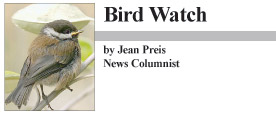Pugnacious siskins
 At six o’clock this morning, a single goldfinch was huddled on the seed feeder outside our kitchen window, but within a few minutes there were more goldfinches than our two feeders could hold. Many tried to land, falling backward into the air, as those who occupied perches thrust out their beaks to keep them away. In the flurry of activity, it looked to us as though no one was actually getting very much to eat.
At six o’clock this morning, a single goldfinch was huddled on the seed feeder outside our kitchen window, but within a few minutes there were more goldfinches than our two feeders could hold. Many tried to land, falling backward into the air, as those who occupied perches thrust out their beaks to keep them away. In the flurry of activity, it looked to us as though no one was actually getting very much to eat.
An hour later, I am seated in front of the window enjoying my breakfast, and trying to count birds. This is one of the days I have agreed to submit a report to Cornell Lab of Ornithology’s Project Feeder Watch, but it is difficult to count the ever-moving goldfinches. I settle on 22, although there could easily be twice that number fluttering back and forth. A minute later, I raise my estimate to 29 goldfinches on the feeders and the deck, and another seven or eight in the maple tree. At this time of year, most are beginning to show yellow on their throats and a patch of yellow on the shoulder. A few have irregular patches of yellow on the belly, and one male even has the beginnings of a blackish cap tipped down low over his forehead.
A few pine siskins are mixed in with the flock of goldfinches. They are the same size, but the siskins are heavily streaked with brown, most have a touch of yellow in the wings or at the base of the tail, and their bill is slightly longer and more pointed. Chickadees dart in to the feeders, and two tufted titmice manage to grab a few seeds. The goldfinches are doing their best to keep everyone away, but the most pugnacious bird on the feeder is a pine siskin. This one not only thrusts out its bill to drive away any birds who dare to approach, it flies up and physically pushes them off the feeder. When one bird lands on the feeder the siskin hops up onto its back, and stays there flapping its wings and pecking, until the interloper falls away into the air.
This winter, a small number of pine siskins have visited our feeders regularly. Siskins breed in Maine and as far north as Labrador and Alaska, but the size of their winter population in Maine varies from year to year. Ron Pittaway, who writes The Winter Finch Forecast for 2011–2012, published by the Ontario Field Ornithologists, studies and predicts the seasonal movements of northern finch species, including pine siskins. In order to develop his Forecast, Pittaway collects data from an impressive list of sources, who report on bird populations and their food supplies from Newfoundland to Alaska, and even New Hampshire and New York State. He reports that because cone crops across the boreal forest of Canada were excellent in 2011, most species of northern finches, including redpolls, purple finches, crossbills, and pine grosbeaks, would be able to find plenty of food there. This was not expected to be a flight year, meaning that finches would not have to come south, but would remain spread over a vast northern area. The Forecast includes information on 10 species, including the pine siskin, which he describes as a nomadic spruce seed specialist. He reports there were large numbers of siskins in Yukon, including a large population of hatch year birds (birds hatched in 2011). Because the spruce crop in Yukon and Alaska is only average, siskins were expected to be on the move, possibly spreading out to the east, to take advantage of our excellent spruce and hemlock crop.
In a 1998 article published in the OFO (Ontario Field Ornithologists) News, Ron Pittaway wrote that pine siskins are aggressive at feeders, and will fight with goldfinches, other siskins, and even the larger purple finches. I could show that article to the feisty goldfinches on our feeders, who are being pushed and shoved around by our aggressive little siskin, but it would only be telling them something they already know.

